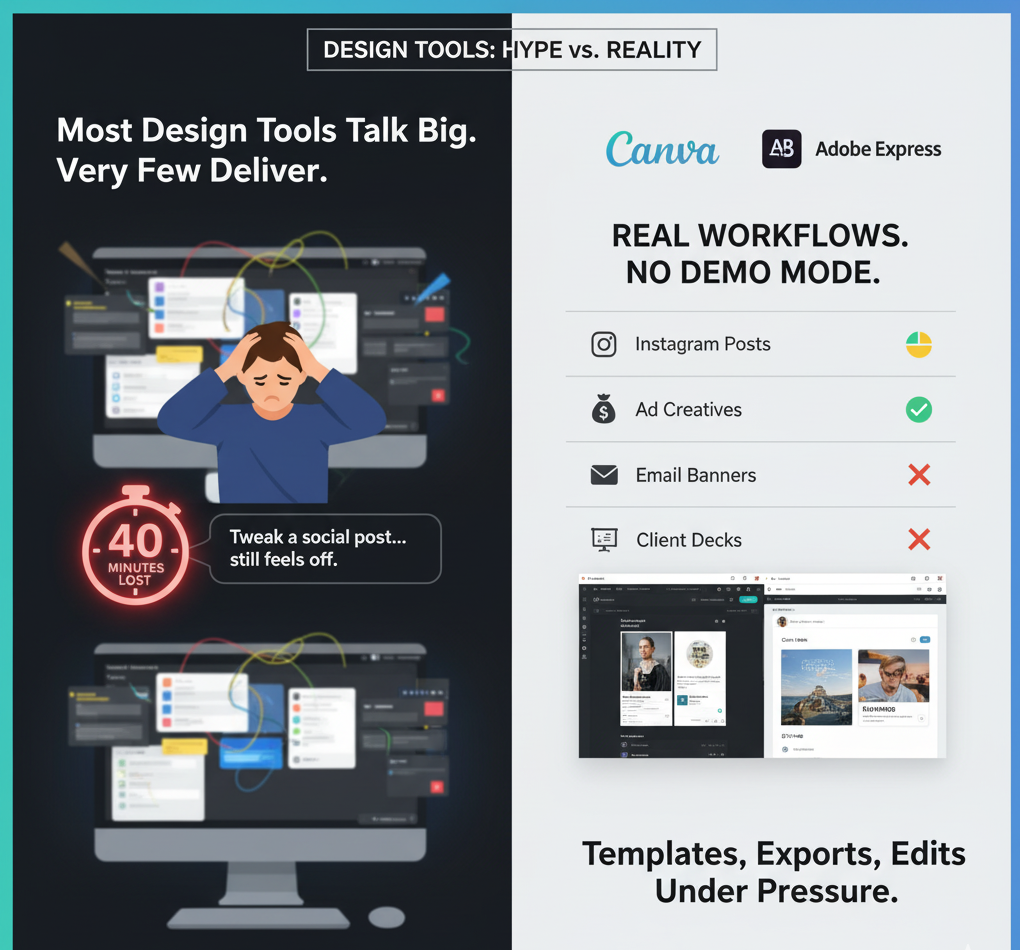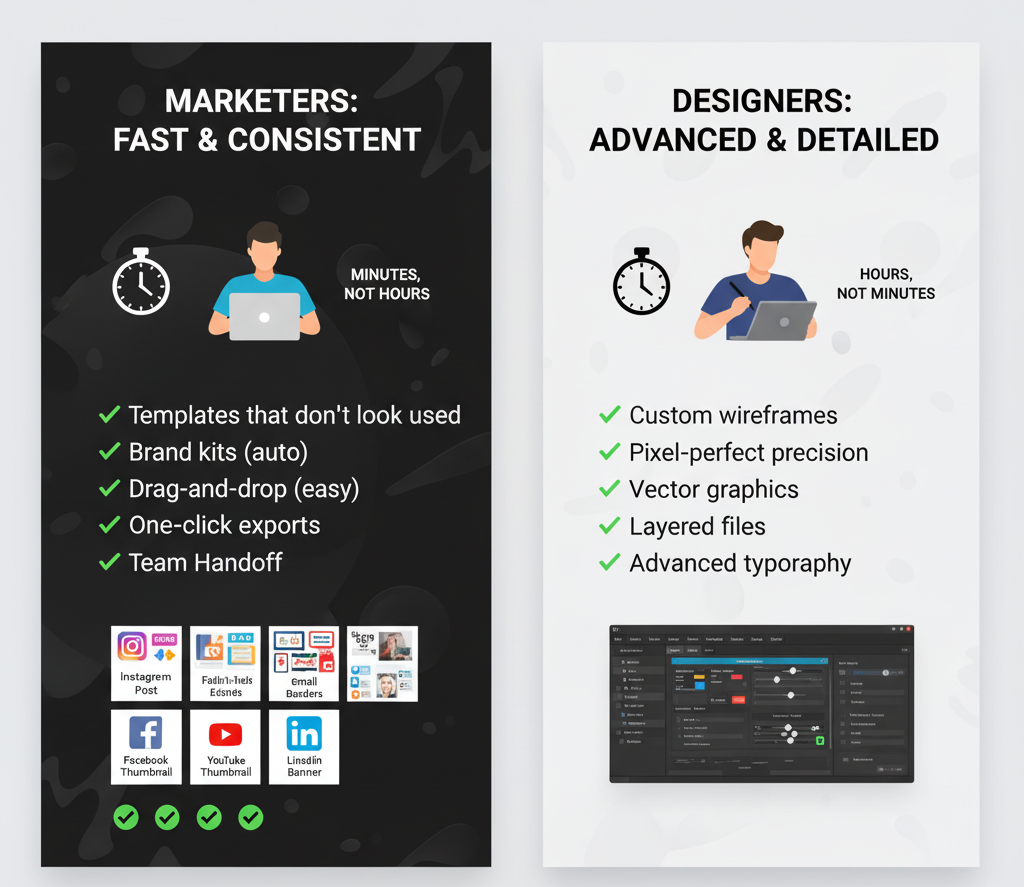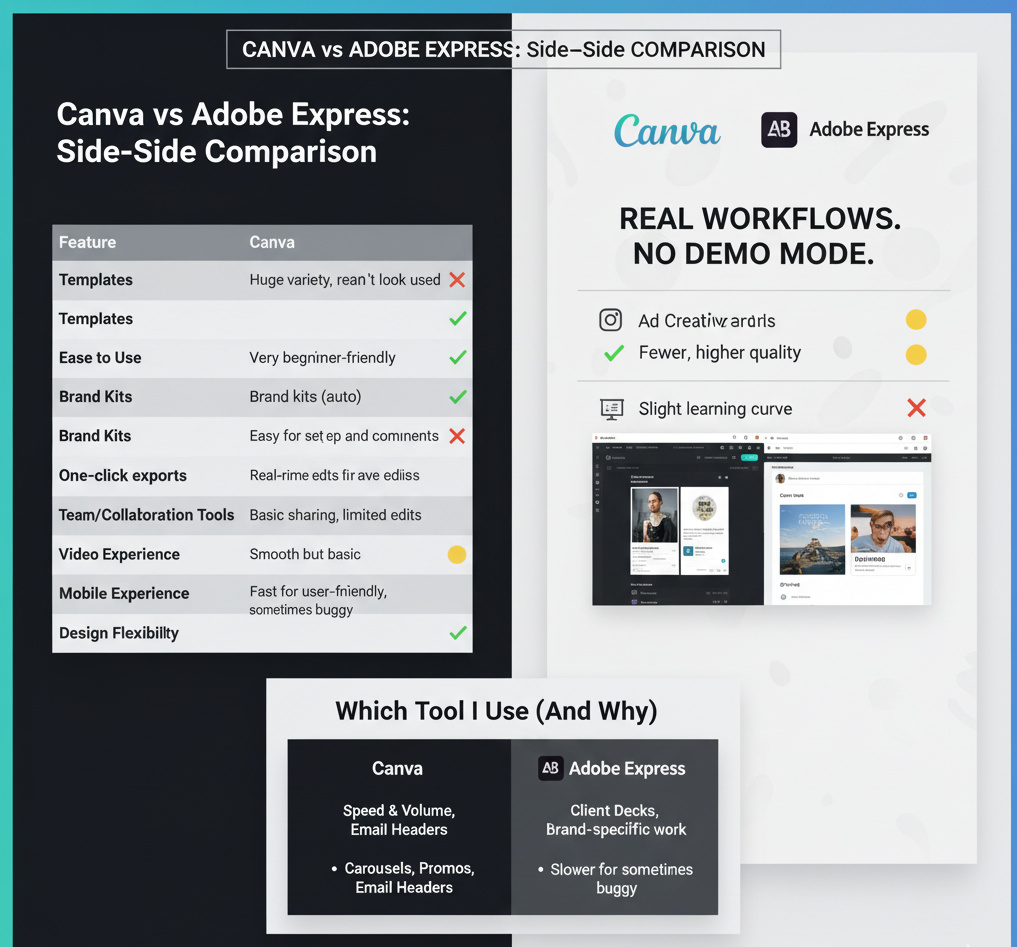Most Design Tools Talk Big. Very Few Deliver.

If you’ve ever lost 40 minutes trying to tweak a social post, just to end up with a layout that still feels off, you’re not alone.
Marketing moves fast. Design tools should keep up. But most don’t.
This isn’t a generic comparison filled with marketing jargon. I’ve tested both Canva and Adobe Express inside real workflows not demo mode. Instagram posts. Ad creatives. Email banners. Client decks. Templates, exports, edits under pressure.
So here’s the breakdown. Real use cases. Where each tool wins. Where each one gets in your way. No bias. No fluff.
What Marketers Actually Need from a Design Tool

Designers have hours to tweak details. Marketers don’t.
You need to build posts fast, keep branding consistent, and push content across platforms daily. You’re not sketching wireframes. You’re building offers, testing hooks, and keeping the visuals sharp enough to stop a scroll.
Here’s what matters:
- Templates that don’t look like they were used 1,000 times
- Brand kits that load automatically
- Drag-and-drop layout you can learn in minutes
- One-click exports for social, ads, and email
- Tools that help your VA or teammate pick up where you left off
What you’re probably building:
Instagram carousels. Facebook ads. YouTube thumbnails. Blog visuals. LinkedIn banners. Weekly promos. Email headers. Landing page graphics.
If the tool slows you down, it doesn’t matter how “advanced” it is.
Read my honest review in SEMrush vs Ahrefs: Which One I Actually Use and Why blog.
Canva: What Works, What Doesn’t, and Who It’s Built For
Canva feels built for people who need to move.
You can open it, drop in a few elements, tweak text, and export a solid-looking post in under 10 minutes. It has templates for nearly everything from Instagram Stories to pitch decks. It’s fast, forgiving, and you don’t need design experience to get good results.
What works well:
- It’s quick. You don’t get stuck in setup.
- It has thousands of templates that feel modern.
- You can share files and collaborate without jumping between apps.
- Integrates with Notion, Google Drive, HubSpot, etc.
But here’s where it struggles:
- Exported files sometimes lose sharpness (especially for ads or print).
- You hit limits when trying to do custom layouts or advanced design tweaks.
- The mobile version can be glitchy or clunky during edits.
Verdict:
Use Canva if you need speed. If you’re posting daily or running lean teams, this tool gets the job done fast. Most marketers won’t outgrow it. But if you care about typography or tiny brand details, you’ll feel its ceiling.
Adobe Express: Where It Surprised Me and Where It Didn’t
Adobe Express is slower out of the gate, but more polished once you get going.
The visual quality feels higher. Fonts look sharper. Layouts feel more pro. It doesn’t hand you 50 template options but the ones it gives are better built. If you already use Lightroom, Photoshop, or Stock, Express plugs in seamlessly.
What it does well:
- Templates have better structure and spacing
- You can build brand kits with detailed control
- Connected to Adobe Stock, Lightroom, and Creative Cloud
- Resize tools are cleaner, great for repurposing posts
Where it struggles:
- Takes longer to learn, especially for beginners
- Browser version can lag, especially on older machines
- Fewer templates compared to Canva
Verdict:
Use Adobe Express when brand control matters more than speed. It’s built for marketers who care how every asset looks and who already live in the Adobe ecosystem.
Canva vs Adobe Express: Side-by-Side Comparison

| Feature | Canva | Adobe Express |
|---|---|---|
| Templates | Huge variety, ready to use | Fewer, higher quality |
| Ease of Use | Very beginner-friendly | Slight learning curve |
| Brand Kits | Easy to set up and apply | More advanced, but takes time |
| Team Collaboration | Real-time edits and comments | Basic sharing, limited live edits |
| Video/Animation Tools | Great for short-form content | Smooth, but basic |
| Mobile Experience | Fast and user-friendly | Slower and sometimes buggy |
| Design Flexibility | Enough for most marketers | Better for brand-specific work |
Which Tool I Use (And Why)
I don’t stick to one tool. I switch based on the job.
- Canva for everyday content carousels, promos, email headers
- Adobe Express for brand launches or when I need sharp visuals
- Canva for speed and volume
- Adobe Express for client decks or design-heavy campaigns
Bottom line:
You don’t need to choose. You just need to know when to use what.
Mistakes I See Marketers Make With These Tools
1. Using templates without changing anything.
Your post looks like everyone else’s. Spend five minutes customizing.
2. Ignoring brand kits.
Suddenly, your fonts, colors, and tone look different across platforms.
3. Over-designing.
It’s tempting to add icons, effects, and shadows, but if the message isn’t clear, no one cares.
4. Exporting in low resolution.
That blurry image you just uploaded? That’s hurting your ad results.
Tip:
Clean design supports the message. It doesn’t compete with it.
Bonus Tools That Save Me Time
Here are the tools I keep next to Canva and Adobe Express every day:
| Tool | Use | Works With | Why I Use It |
|---|---|---|---|
| Remove.bg | Removes backgrounds fast | Both | Saves time on product/image cutouts |
| TinyPNG | Compresses files without blur | Both | Better performance on sites and emails |
| Notion | Content planning | Canva | Organizes drafts, embeds previews |
| Grammarly | Caption cleanup | Both | Keeps copy clear, direct, typo-free |
Want to stop wasting time on the wrong tools?
Follow Shehnoor Ahmed for real-world reviews, smart marketing systems, and the exact tech stack that powers high-performance content without the guesswork.
Business Inquiries: Hello@shehnoorahmed.com
FAQs
Can I use both tools?
Yes. I do it every day.
Which one’s better for beginners?
Canva has no learning curve.
Is Adobe Express worth paying for?
If you already use Adobe tools and care about design quality, yes.
Can either replace a designer?
For daily content? Mostly, yes. For brand identity? You still need a designer.
What about teams?
Canva has the strongest real-time collaboration tools right now.





